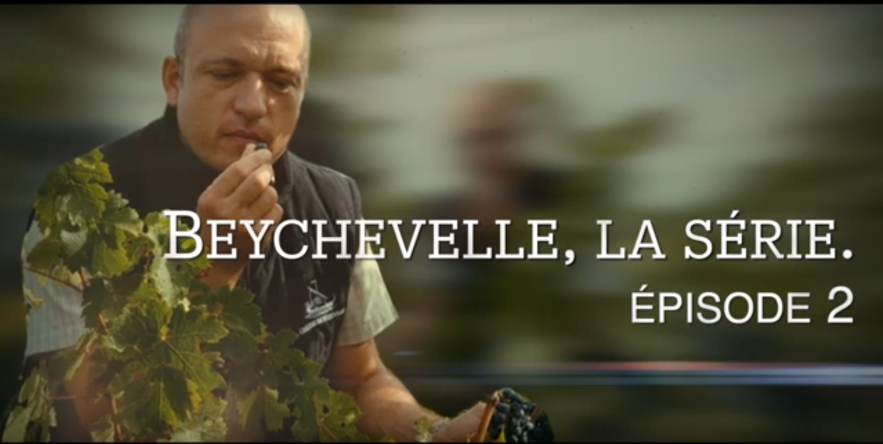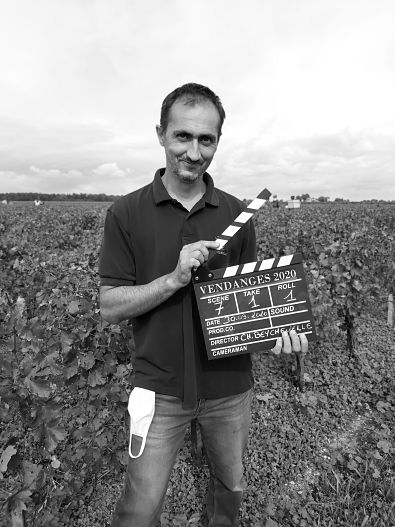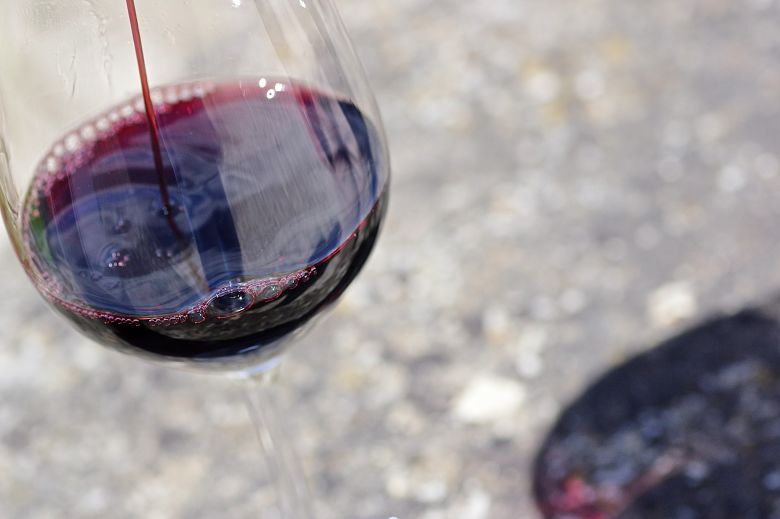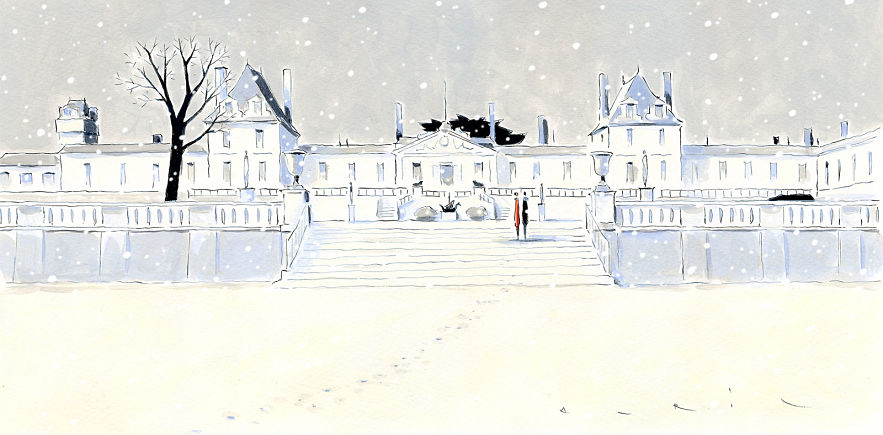BY NEAL MARTIN | MARCH 21, 2023
Apart from interesting backstories, Beychevelle has passed between some of the most powerful families in France over nearly a millennium. This article stems from a vertical tasting of 25 vintages marking the quarter-century of Philippe Blanc’s tenure, plus a handful of notes for wines back to 1929.
Mooning. According to the Collins English Dictionary, mooning is defined as “The act of showing your naked bottom in public as a joke or as a protest.” It dates back to Roman times when it was used to mock enemies. Flavius Josephus recorded the gesture at the beginning of the Roman-Jewish war when a Roman soldier mooned at Jewish pilgrims assembled for Passover. It did not end well. The resulting riot and stampede led to thousands of deaths. Mooning really became popular in medieval times, most notably on the battlefield. Memorably recreated in the film Braveheart, when the Scots hoist their kilts to mock the English, in fact, historians suggest it is more likely that English buttocks saw fresh air before the bloodshed began. The ritual persists to this day. Every classroom contains one unruly lad who will drop his trousers at the merest provocation; the wider the audience, the better. Favored location is the coach trip. Somewhere down the motorway, egged on by his ululating mates, he will moon out the window to embarrass passing drivers before the teacher hears the commotion and marches down the aisle yelling: “PULL YOUR TROUSERS UP, YOU ‘ORRIBLE LITTLE BOY.”
I know what you are thinking. Why am I discussing mooning in a piece devoted to Château Beychevelle? The story of passing ships lowering their sails as they passed Beychevelle to honor the admiral of the French fleet, the Duc d’Épernon, is well known. But to my own surprise, writer Bernard Ginestet not only casts doubt on that apocryphal tale, but suggests that not everyone was so deferential. For reasons that I shall explain, the didactic duke had many foes. Those wishing to express their feelings another way would purportedly stand on deck to lower not the sail, but their trousers, exposing their backside in the duke’s direction. Suffice it to say that this insult is not depicted on the label of Beychevelle.

The iron statue of a shipping vessel became the emblem of Beychevelle.
History
For this article, I delve a little deeper than usual into the ancestral roots of Beychevelle. Apart from interesting backstories, over almost a millennium, Beychevelle passed between some of the most powerful families in France. Its roots can be traced back to the seigneurie of Lamarque, one of a series of fortified maisons designed to protect the Médoc. In the 15th century, the land belonged to the Foix de Candale family, often associated with Château d’Issan. In 1587, their only daughter and heiress married Jean-Louis Nogaret de la Valette, the Duc d’Épernon, later appointed Governor of Guyenne. Quoting the ever-quotable writer Bernard Ginestet, he was “an ambitious, pushy opportunist” who amassed considerable wealth and power and was instrumental in the accession of Henri IV. During this era, merchant ships, not only French, that sailed past the property would lower their sails as a gesture of fidelity towards the Admiral of France, one of the duke’s innumerable titles. The origin of Beychevelle’s label depicts a ship decorated with a griffon on its prow in the act of lowering its sail. In Gascon, this act is known as Bêcha vela, or baisse voile – lower the sails. One would assume that is the etymology of “Beychevelle”.
Ginestet is surprisingly skeptical that ships performed this ritual, pointing to the fact that the Duc d’Épernon spent most of his time at other residences. In fact, both he and his son Bernard were unpopular autocrats that unscrupulously extracted every last penny from their tenants. Ginestet mentions how the site was rumored to host occult rituals and witchcraft in the 16th century. Hence its local name prat Lauret, Gascon etymology for a place where evil things happen. I suspect the rumors might stem from embittered locals seeking to bad-mouth their landlord.
The seigneurie was broken up after its proprietor died in debt in 1661 to form what became familiar Saint-Julien estates such as Ducru-Beaucaillou and Branaire-Ducru. In 1674, the Duc de Rendan, Baron de Beychevelle, acquired the stretch of land that ultimately became Beychevelle, and Ginestet posits that a Cru was produced under that name. It passed to the d’Abbadie family in 1692, whom some say let the estate go to seed. However, Ginestet feels that this is harsh, especially since under their tenure, vines were expanded, and by the mid-18th century, its wine fetched a respectable 400 to 600 livres per tonneau. In 1757, it fell into the hands of François-Etienne, Marquis Brassier de Budot, another parliamentarian. He demolished the original manoir and constructed the château that stands today and the surrounding gardens designed by the famed jardinière, Le Nôtre. De Budot also developed the small port that lies on the Gironde Estuary behind what is now Beychevelle in the days when river transport was crucial for ferrying barrels down to the city, enabling him to control the distribution of local merchandise and levy taxes accordingly.
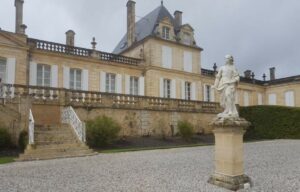
The front façade of the château.
The 40 hectares of vine saw some much-needed replanting and improvement. The land passed to Brassier’s son François Arnaud who became extremely wealthy. His riches put him in a spot of bother come the French Revolution. Much of his vast expanse of land was seized, and he was incarcerated inside the château. Having escaped, locals hunted him through the marshes, but he survived and was eventually exiled after a duel where he killed his adversary. After a few years, his sister persuaded the authorities that she was the rightful heir, though inexplicably, in 1800, she sold the estate to a Bordeaux ship-maker, Jacques Conté.
The estate was comparatively large at around 250 hectares, the same as the present day, a polyculture of vines, cereals and pasture, though it was said to be in substandard condition at the time. In 1825, Conté sold it to the son of merchant Daniel Guestier, Pierre-François. He is an intriguing man, a keen equestrian who bred a thoroughbred stallion, Young Governor, that sired champion horses and laid the foundation for the popularity of horseracing in Bordeaux that flourishes today. In 1855, Beychevelle was classed as a Fourth Growth in the Bordeaux Classification. Unfortunately, Guestier’s fortunes took a downturn after it suffered widespread mildew, and he was obliged to pay the dowries for his six daughters. Consequently, he was forced to sell Beychevelle in 1875 for 1.6 million Francs. The buyer was Armand Heine, cousin of German poet Heinrich Heine. Heine’s daughter married into the Foulds, one of the wealthiest banking dynasties in France, and they presided over Beychevelle for more than a century. They were particularly well-connected politically, Armand Heine’s daughter Marie-Louise marrying parliamentarian Charles Archille-Fould in 1890, their son Armand serving as a French minister in the 1930s, and their grandson Aymar as French Postmaster General.
In 1984, a minority of shares was bought by insurance company GMG, and when Aymar Achille Fould died in 1986, the company acquired 89% of the shares. (They also set up a subsidiary company in which a Japanese beverage company and owners of Château Lagrange have a stake, which acquired Château Beaumont. This is why it is often shown at the property.) Under the new corporate ownership, they began investing in the winery and cellars.
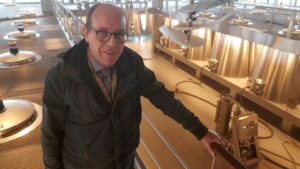
Philippe Blanc, pictured on the upper tier of the winery.
The new era for the estate began with the arrival of estate manager Philippe Blanc in 1997. I have known him almost my entire career and found him one of the most candid winemakers on the Left Bank, armed with a wickedly dry sense of humor. In another life, I am sure he could have been a successful stand-up with a dead-pan delivery. His parents were not connected with wine, although he told me his grandparents lived in Mercurey. They were also not involved in wine, but his childhood was spent walking the vines of Burgundy. In the 1980s, he dreamed of working in Australia and entertaining winemaking as a possible career. He studied agronomy and qualified to study at the Institut National Agronomique Paris Grignon. During the second year, he discovered that wine science was more fun than cereals or dairy, and therefore completed a degree in viticulture at Montpellier. After graduation, he worked in Alsace and the Jura before working several years in Tasmania at Taltarni Vineyards and, later, Clover Hill. In 1993, he was sent back to France in order to manage an estate in Bergerac that Taltarni’s proprietor was planning to buy. Unfortunately, the deal never went through, leaving Blanc without work. He ended up in charge of making a liqueur from orange juice and cognac called “Alize” which turned out to be amazingly successful. But in the summer of 1995, he heard that Beychevelle was looking to hire, and to his own surprise, he was appointed to join the prestigious estate. I asked Blanc if he remembers his first day “in the office”?
“The first day I came to Beychevelle was a Saturday morning,” he tells me. “I came from Agen to visit the place and meet my predecessor, who guided me in the cellar. I had no hard challenge like a tasting exam that applicants have to overcome. I was impressed by the place but maybe thought it was a bit old-fashioned, particularly the vat room.” Blanc gave Beychevelle a sense of stability. In 2012, he was joined by wingman Romain Ducolomb, who transferred over from Clinet in 2012.
I ask Blanc what that Right Bank experience has bought to this Left Bank château.
“I was happy to reinforce the team with another qualified winemaker who was a gold medalist! He brings a lot of attention and dedication. Part of the winemaking precision is his. He discovered that a 90-hectare vineyard has different issues compared to a 10 to 15-hectare property and that Merlot in Médoc is not identical to Merlot in Pomerol. I want to be part of the final decision in terms of picking dates and the final blend, but we do work in a complementary fashion. We sometimes have different points of view, but we agree more than 90% of the time. It’s fun to see the last 10% with different perspectives, and that broadens the possibilities. We try, taste and then agree on a final decision.”
The Vineyard
Beychevelle encompasses some 250 hectares, of which 90 hectares are under vine. Part of the vineyard lies in front of its neighbor Ducru-Beaucaillou, where the D2 swings 90° in front of Gloria, deceiving passers-by into thinking that these propitious parcels belong to the Second Growth. Another plot beyond the Saint-Julien boundary in Cussac-Fort-Médoc has special derogation to be included in the Grand Vin, though it is more often blended with the Second or Third wine. The non-vinous swathes are devoted to grazing Limousin cows, pine forests, poplar and ash. The current composition of varieties is 52% Cabernet Sauvignon, 40% Merlot, 5% Cabernet Franc and 3% Petit Verdot planted at a density between 8,300 and 10,000 vines per hectare. This represents the highest proportion of Merlot in the appellation, and you could argue that this has hampered Beychevelle’s potential as there are plots on Günzian gravel soils more suitable for Cabernet Sauvignon. Indeed, the long-term plan is to increase Cabernet Sauvignon in the future.
I ask Philippe Blanc about the rootstock used in the vineyard.
“In terms of rootstock, we do not have many changes, except that 20 or 25-years-ago, I was chasing low-vigor rootstock such as Riparia Gloire. Today we consider them as being prone to suffer more during drought, and their vigor is too low. But basically, most of our plantings are on 101-14, which was the case prior to my era. Sometimes we have plots used for trials, for example, Gravesac or even Nematex, though the latter’s vigor is too low, so that is a no-go. What I discovered over the years, with cooperation with Bordeaux Science Agro and our R&D cell called Vitinnov, is the huge impact of nematodes in our soils. We systematically conduct soil sampling to monitor the nematode population and let the soil rest longer than ever before replanting. Of course, in many spots, Cabernet Sauvignon will replace Merlot plantings, but we do it with a very moderate pace.”
Regarding vineyard husbandry, one-third of the vines are farmed organically or lutte raisonée, with no herbicides used across the entire estate. Since 2008, they have endeavored to increase biodiversity by planting hedgerows. Blanc furnishes me with detail on this topic.
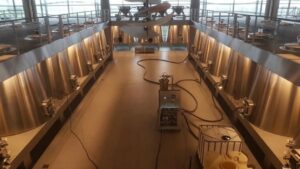
The Beychevelle vat room.
“For about 12 years, we applied organic viticulture on our Haut-Médoc vines and plots around to the point we reach about one-third of vineyard acreage. I wanted to be sure we were technically able to implement organic viticulture should it become compulsory. We went as low in terms of yield as 13hL/ha in 2013. But in 2020, we decided to stop following the rules by the letter and considered the use of non-organic products if we have to. The owners did not want to accept the implied risk of becoming a fully organic vineyard. It is important to point out that we banned insecticides and miticides in 1997 (replaced by using pheromones) as well as banned herbicides in 2008, CMR sprays in 2015 and have not used anti-botrytis sprays for the last five years. Most of our program is based on organically-approved sprays for most of the cycle, and we stopped any spraying in June 2020 and 2022, and even July 2021. So, we try to have wines as clean as possible from pesticide residues. All our fertilizers are either produced on the vineyard as compost or are organically compatible. There are changes that we try to master and changes that fall on us and that we only can observe or take into account. That is the implication of global warming.”
The harvest is undertaken manually per variety, vine age and type of terroir. “Romain Ducolomb and I visit the blocks and taste the berries. There is some analysis of polyphenols in order to compare the current vintage to previous ones. Then according to our observations and tastings, we decide if we must be patient or if we can start picking. Since 2013, we have had pickers coming from Spain, Morocco or Romania through a contractor. They pick a bit more than half the property and are quicker than locals! Labor is a real issue. It would be practically impossible for us to hire 100 pickers ourselves. That is a shame, but that is the way it is, and it will just keep getting worse.”
The fruit undergoes a triple sorting, including optical, that I have inspected first-hand on several occasions during picking. Since the construction of the new reception area, the picking team has much more space to operate, and it works like a well-oiled machine.
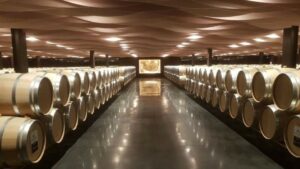
The Beychevelle barrel cellar.
The Winery
The new winery was completed in time to receive the 2016 vintage. Driving past during the months of construction, there was so much glass that I wondered whether they were building a supermarket. How facetious! Of course, all those floor-to-ceiling panes are to permit plenty of natural light to flood the winery. Soon after it was completed, Blanc gave me a tour, and I remember him taking me up to the roof, where he joked, or perhaps half-joked, that it was the perfect place for a barbecue with views across the estuary. “We were totally in charge of deciding what winemaking tools we wanted. We had, of course, some limits as soil surface available and a budget that was certainly not unlimited. But we managed to build a very high-performing, convenient facility.”
“We decided to go for 100% stainless steel with smaller sized vessels compared with the previous winery. To enhance extraction, we installed 59 troconic-shaped vats that are adapted to pigeage or punching down. [In addition, Ducolomb has introduced manual punch down during vinification.] We decided on various vat sizes: 73, 105, 120 and 160 hectoliters in accordance with average block productions. In the old winery, 160 hectoliters was the average capacity of vat. We dedicate the larger vats mainly to the Haut-Médoc wine and blocks for the Deuxième Vin. One important point is that we wanted gravity-feeding and no pumping of the must, so we use 500-kg cuvons and a lift to go over the top and fill the vats. Our temperature control is very efficient, and we can reduce the temperature of must below 10°C in order to extract at low temperatures for a few first days. I am very convinced that we have improved the tannic structure of our wines since 2016. Tannins are more present, but they are more precise, sharper, like a Japanese cooking knife. We gained in balance and harmony and are in the search of perfection.”
I ask Blanc about the élevage at Beychevelle.
“We increased the ratio of new barrels as every time we tasted blind, we gave better scores to higher ratio new wood blends. Today we use around 70% new barrels with medium to medium-low toast, and for the Grand Vin, the wine is aged over 18 months. We take great care of reducing oxidation and decided to rack with nitrogen transfer. Unlike in the past, we do not rack systematically every three months but check the presence of lees before any racking. We still liquid-egg fine, but we check the dose, which is very low compared with what used to be done in the old time.”
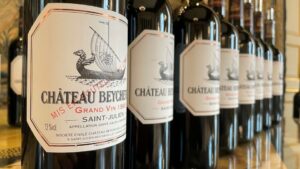
The Wines
This article stems from a vertical tasting of 25 vintages marking the quarter-century of Philippe Blanc’s tenure. They were not served chronologically but rather organized into flights based on reputation, prompting my protest that 2008 did not deserve to be amongst the also-rans. These are supplemented by a handful of older vintages from 1929, though I have encountered far fewer examples over the years than its Saint-Julien peers. In particular, the decades of the Sixties and Seventies are relatively fallow in terms of notes, an era when the wines were said to be below par. Indeed, you have to go back to the post-war period; my personal highlight is a stellar 1949 Beychevelle poured at Chez Bruce with Oz Clarke and TV host Philip Schofield (it has an amusing backstory that I won’t go into here). It was a bottle that reset my appreciation for Beychevelle in this era and demonstrated the heights achievable in that period. I also have fond memories of a 1937, though found the 1929 Beychevelle, opened at the château, fading gracefully with time, not unlike a few from this growing season.
The main event spanned the years from 1995 up to the recently-bottled 2019, every vintage overseen by Blanc. My scores don’t lie. This vertical proves that the château’s wines have most definitely improved, but that is a recent phenomenon. You could argue that it is only since 2015 that one can confidently say that Beychevelle is achieving its full potential so that its wines can hold a torch to the aforementioned 1949. Vintages from the late Nineties feel undernourished, a little hollow and afflicted intermittently by Brettanomyces. Frankly, the wines are not as clean as they ought to be. It is the 2000 and 2001 Beychevelle that prefigure the surge in quality, particularly the latter, where you find more definition and focus on the nose, a pleasing tautness on the palate, with a touch of pepperiness on the finish.
It is not until the 2005 Beychevelle that these heights are replicated, grippy and structured in keeping with the common traits of the vintage, missing finesse yet with a satisfying, quite muscular finish. The 2008 Beychevelle is the first that genuinely transcends the limitations of the season and is perhaps underrated by the château team themselves. There is a wonderful sense of classicism here and just the right amount of dryness and sapidity that urges you back for another sip. This is followed by excellent performances not only in 2009 and 2010 but also little gems in 2011 and 2012. Beychevelle is finally regaining a sense of consistency that had eluded them in recent years. The one perplexing showing came with the 2014 Beychevelle with an incongruous mintiness that perhaps comes from the unprecedented proportion of Merlot and the small yields.

Final Thoughts
I ask Philippe Blanc what the future holds for Beychevelle.
“The future is a future without Philippe Blanc, and I hope it will be for the better,” he replies. “We still need a bit of patience and luck. As you know, health is part of the equation. I hope to be around for another few vintages, and then I will be happy to leave the place in good shape, Beychevelle, not me! For new varieties, I am pushing to start trials as it will be a slow and long process to work out if any ‘old’ varieties or foreign varieties can be of interest in Saint-Julien, and whether they can make great wines. You have several years of observing aspects such as growth, disease and yield in the vineyard, then the quality of wines, their blending capacity, aging ability and so on. In the coming years, there will be labor issues and environmental evolution, the effect of global warming on vines but upon working conditions as well. There is still plenty to do.”
I look forward to tasting the next quarter-century of wines under Philippe Blanc. And in case you are wondering if he mooned in the middle of our vertical tasting to show his disaffection towards any of his Saint-Julien neighbors, rest assured, he did no such thing…at least not in my presence.
© 2023, Vinous. No portion of this article may be copied, shared or re-distributed without prior consent from Vinous. Doing so is not only a violation of our copyright, but also threatens the survival of independent wine criticism.

